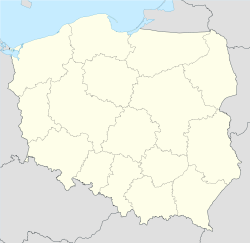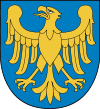Bielsko-Biała
| Bielsko-Biała | |||
 |
|||
|
|||
 Bielsko-Biała
|
|||
| Coordinates: | |||
| Country | |||
|---|---|---|---|
| Voivodeship | Silesian | ||
| County | city county | ||
| Town rights | 1312 Bielsko 1723 Biała |
||
| Government | |||
| - Mayor | Jacek Krywult | ||
| Area | |||
| - City | 124.51 km² (48.1 sq mi) | ||
| Highest elevation | 1,117 m (3,665 ft) | ||
| Lowest elevation | 262 m (860 ft) | ||
| Population (2006) | |||
| - City | 176,678 | ||
| - Density | 1,419/km² (3,675.2/sq mi) | ||
| - Metro | 700,000 | ||
| Time zone | CET (UTC+1) | ||
| - Summer (DST) | CEST (UTC+2) | ||
| Postal code | 43-300 to 43-382 | ||
| Area code(s) | +48 033 | ||
| Car plates | SB | ||
| Website: http://www.um.bielsko.pl | |||
Bielsko-Biała [ˈbʲɛlskɔ ˈbʲawa] (![]() listen) (German: Bielitz-Biala; Czech: Bílsko-Bělá) is a city in southern Poland with 176,987 inhabitants (2006).
listen) (German: Bielitz-Biala; Czech: Bílsko-Bělá) is a city in southern Poland with 176,987 inhabitants (2006).
Bielsko-Biała is made of two former cities on opposite banks of the Biała River, Bielsko and Biała, amalgamated in 1951. Situated in the Silesian Voivodeship (since 1999), the city was previously capital of Bielsko-Biała Voivodeship (1975-1998). Bielsko-Biała is one of the most important cities of Euroregion Beskidy.
Contents |
History
Between 1933 and 1938 an archaeological team discovered remains of a fortified settlement in what is now Stare Bielsko (Old Bielsko) district of the city. The settlement was dated to the 12th - 14th centuries. Its dwellers manufactured iron from ore and specialized in smithery.
The current center of the town was probably developed as early as the first half of the 13th century. At that time a castle (which still survives today) was built on a hill.
In the second half of the 13th century, the Piast Dukes of Opole (Oppeln) invited German settlers to land between Silesia and Lesser Poland in order to colonize the Silesian Beskids. Nearby settlements west of the Biała River were Nikelsdorf, Kamitz, Alt-Bielitz (now Stare Bielsko), Batzdorf and Kurzwald. Nearby settlements east of the river Bialka were Kunzendorf, Alzen and Wilmesau. Nearby settlements in the mountains were Lobnitz and Bistrai.
After the partition of the Duchy of Oppeln in 1281, Bielsko passed to the Dukes of Cieszyn (Teschen). The town was first documented in 1312 when a Duke of Cieszyn granted a town charter. From 1457 the Biała River was the border between Silesia (within the Holy Roman Empire) and Lesser Poland. The town of Biała was established on the opposite bank of the Biała River in 1723.
During the First Partition of Poland in 1772, Biała was annexed by Austria and included in the crownland of Galicia. In 1918 both cities became part of a reconstituted Polish state, even though the majority of the population was ethnic German. During World War II the city was annexed by Nazi Germany and its Jewish population was sent to Auschwitz concentration camp. After the liberation of the city by the Red Army in 1945, the ethnic German population was expelled westward.
The city of Bielsko-Biała was created on January 1, 1951 when the adjacent cities of Bielsko and Biała were unified.
Economy and Industry
Nowadays Bielsko-Biała is one of the best-developed parts of Poland. It was ranked 2nd best city for business in that country by Forbes. About 5% of people are unemployed (compared 9,6% for Poland). Bielsko-Biała is famous for its textile, machine-building and motor industry. In Bielsko-Biała there are four areas that belong to Katowice Special Economic Zone.
Sights
- The Bielsko-Biała Museum, housed in the castle of the Dukes of Cieszyn from XV age, later Castle of the Sułkowski princes
- Prezydent Hotel
- Train Station (Bielsko-Biała Główna) from 1888
- Jewish Cemetery founded in 1849
- Theater built in 1890
- St. Nicholas' Cathedral from 1447 and rebuilt in 1909 - 1910
- House of Frogs, an Art Nouveau mansion
- The Bielsko Biala Gallery of Art, galeria BWA
- Weaver's House, Dom Tkacza, reconstructed workshop of a draper
Boroughs
- Biała
- Stare Bielsko
- Straconka
- Mikuszowice Śląskie i Mikuszowice Krakowskie
- Aleksandrowice
- Wapienica
- Olszówka Dolna i Olszówka Górna
- Hałcnów
- Komorowice Śląskie i Komorowice Krakowskie
- Leszczyny
- Lipnik
Education
- University of Bielsko-Biała
- The Academy of Computer Science and Management
- Bielska Wyższa Szkoła Biznesu i Informatyki im. J. Tyszkiewicza
- Wyższa Szkoła Administracji
- Wyższa Szkoła Bankowości i Finansów
- Wyższa Szkoła Ekonomiczno-Humanistyczna
- Teacher Training College of Bielsko-Biała
Politics
Bielsko-Biała constituency
Members of Parliament (Sejm) elected from Bielsko-Biała constituency
- Jacek Falfus (Law and Justice - PiS)
- Tadeusz Kopeć (Civic Platform - PO)
- Kazimierz Matuszny
- Rafał Muchacki (Civic Platform - PO)
- Stanisław Pięta (Law and Justice - PiS)
- Piotr Smolana
- Jan Sztwiertnia
- Jan Szwarc
- Stanisław Szwed (Law and Justice - PiS)
- Tomasz Tomczykiewicz (Civic Platform - PO)
- Stanisław Zadora (League of Polish Families - LPR)
Municipal politics
- Mayor - Jacek Krywult
- deputy mayor - Waldemar Jędrusiński
- deputy mayor - Henryk Juszczyk
- deputy mayor - Zbigniew Michniowski
Notable residents

- Shlomo Avineri (born 1933), political scientist
- Maurice Bloomfield (1855-1928), philologist
- Fannie Bloomfield Zeisler (1863-1927), pianist
- Heinrich Conried (1855-1909), theatre manager
- Urszula Dudziak (born 1943), jazz singer
- Roman Frister (born 1928), Holocaust survivor and writer
- Eduard Geyer (born 1944), international trainer
- Hellmuth Karasek (born 1934), journalist, literary critic, novelist
- Selma Kurz (1874-1933), opera singer
- Franciszek Macharski (born 1927), Archbishop of Kraków
- Roman Polko (born 1962), army officer
- Zbigniew Preisner (born 1955), film composer
- Artur Schnabel (1882-1951), pianist
- Grażyna Staniszewska (born 1949), politician
- Albert Schickedanz (1846-1915), architect
- Sabina Wojtala (born 1981), figure skater
- Sigmund Zeisler (1860-1931), attorney
- Hans Zenker (1870-1932), admiral
- Jerzy Stuhr (born 1947), actor and director
- Marian Kasprzyk (born 1939), boxer
- Parents of John Paul II
Sports
- Podbeskidzie Bielsko-Biała - men's soccer team (2nd league 2006/2007).
- BBTS Siatkarz Original Bielsko-Biała - men's volleyball team playing in Polish Volleyball League (Polska Liga Siatkówki, PLS: Seria A in 2003/2004, Seria B in 2004/2005 season).
- BKS Stal Bielsko-Biała - women's volleyball team:Polish Champion 2004, playing in Polish Seria A Women's Volleyball League.
Twin towns

Bielsko-Biała is twinned with the following cities:
|
|
Trivia
Both parts of the name stem from "biel" or "biała", which means "white".
English band SnowByrds recently played the twin cities festival.
See also
- pl:Bielsko-Biała
- Bielsko-Biała Museum
- Sfera shopping mall
- Bolek and Lolek
External links
- Bielsko-Biała - Municipal website
- Bielsko - Aerial photos
- Bielsko-Biała Museum
- Jewish Community Bielsko-Biała
|
||||||||||
|
||||||||||||||
|
|||||||||||||||||



